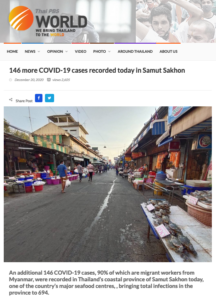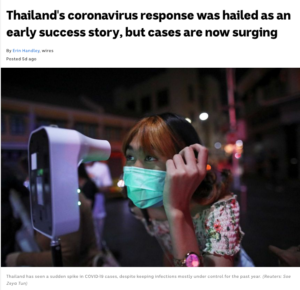8 January 2021
The Work at Sea research is premised on the idea that work on fishing vessels cannot be separated from the global production network for seafood more broadly, which includes transportation, processing, and retailing. Workers in seafood processing, transportation and other ancillary activities are often also migrant workers, who often experience obstacles in access to health care and social security, and other vulnerabilities related to their precarious status in the countries where they work.

https://www.thaipbsworld.com/146-more-covid-19-cases-recorded-today-in-samut-sakhon/
A major outbreak of COVID-19 that began in mid-December in Thailand illustrates the importance of making these links. According to government and media sources, the outbreak began among migrant workers from Myanmar, in a major shrimp market in the coastal province of Samut Sakhorn, near Bangkok. Almost half a million migrant workers mostly from Myanmar work in the seafood processing and ancillary activities in the province of Samut Sakorn in Thailand, of whom many are not documented—that is, do not have legal status to work in Thailand. Industries in this province process much of the tuna consumed in Canada, as well as other seafood bound for export into global supply chains. Raw materials are sourced from global fishing fleets, including vessels operated from Taiwan.
The government responded to the detection of COVID-19 cases among workers in Samut Sakhorn by launching a widespread program to test migrant workers in that province, which revealed hundreds more cases, implying that the virus has been present and spreading for some time. These included many cases in seafood processing facilities. One factory, reportedly part of the Pataya Food Group which exports canned tuna and other species to Europe, apparently had 900 positive cases although media and government coverage has been vague with respect to identifying where this outbreak occurred. Thai Union (the worlds biggest supplier of canned tuna), meanwhile, proactively set about testing all of its close to 30,000 employees in Samut Sakhorn—both migrant worker and Thai citizens--finding 69 positive cases as of 7 January. They indicated that they will continue to operate with tight measures to contain transmission of the virus. The government, in contrast, targeted migrant workers in its policy responses, banning migrant workers from travelling across provincial borders, with severe penalties for violating this ban. This policy was echoed by some coastal provinces such as Surat Thani, which apparently did not want to close its popular tourist sites to internal tourism.
Restrictions targeting the movement of migrant workers, not surprisingly, did not stop infected Thais from carrying the virus to other provinces, while also provoking increased racism toward people from Myanmar. Gambling dens and the movement of gamblers among these sites were also identified as significant for the transmission of the virus across provincial borders, although the government was reluctant to acknowledge that this illegal activity among Thai citizens was taking place and contributed to community spread. The government did finally extend travel restrictions to some Thai citizens, by banning all unnecessary travel across provincial borders in the most affected coastal provinces. As of the writing of this update, cases have been found through much of Thailand, with concentrations in Bangkok and the coastal provinces in the east. We do not yet know if workers on fishing vessels either in Samut Sakorn, or the eastern provinces, have been affected. We also do not know how fishing practices have been affected, as Thai Union and other companies have continued production.
It is not year clear how this outbreak will affect seafood production networks. This is not the first time that the virus has been identified with seafood, with prominent incidents also taking place in markets in China. The domestic market for seafood in Thailand has likely been affected as well—a quick search shows that major supermarkets oriented to middle class consumers are highlighting that their seafood is not sourced from Samut Sakkorn markets. The popular Rimping supermarket chain in Chiangmai, for example, has been displaying on their website a prominent message stating that “Seafood at Rimping are only sourced from their place of origin. NOTHING FROM THE FISH MARKET AT SAMUT SAKHORN.”
 The outbreak has provoked media coverage around the world. Marschke and Vandergeest were recently cited in Australian Broadcasting Network story (available here), noting how migrant seafood workers often live in crowded housing, do not necessarily speak Thai, and may not be able to easily access health services including COVID-19 testing—thus it is not surprising that the outbreak had spread to hundreds of cases before it was discovered. Thailand has been among the jurisdictions that had almost completely stopped community spread of COVID-19. But Thailand's laws penalizing undocumented workers and their employers can deter workers from coming forward when ill. Moreover, because workers depend on their employers for legal status, and for access to social security, government threats against employers will likely push undocumented workers further underground and away from health services and testing. Some NGOs, meanwhile, are arguing that the idea that the outbreak was brought to Thailand by migrant workers who are sneaking across the border is false, and that the reality is that Thai government officials are involved in rampant smuggling of workers from Myanmar.
The outbreak has provoked media coverage around the world. Marschke and Vandergeest were recently cited in Australian Broadcasting Network story (available here), noting how migrant seafood workers often live in crowded housing, do not necessarily speak Thai, and may not be able to easily access health services including COVID-19 testing—thus it is not surprising that the outbreak had spread to hundreds of cases before it was discovered. Thailand has been among the jurisdictions that had almost completely stopped community spread of COVID-19. But Thailand's laws penalizing undocumented workers and their employers can deter workers from coming forward when ill. Moreover, because workers depend on their employers for legal status, and for access to social security, government threats against employers will likely push undocumented workers further underground and away from health services and testing. Some NGOs, meanwhile, are arguing that the idea that the outbreak was brought to Thailand by migrant workers who are sneaking across the border is false, and that the reality is that Thai government officials are involved in rampant smuggling of workers from Myanmar.
While Thailand's outbreak lays bare how the marginalisation of migrant workers can have knock-on impacts for public health, this is not unique to Thailand. There have also been significant outbreaks among migrant workers in Malaysia's rubber glove factories and in housing for construction workers in Singapore. Our project will continue to track how this impacts working conditions and labour relations for migrant fish workers and seafood workers, highlighting both how the identification of infection with migrant workers can lead to racism and racist policies such as those outlined above, but also how the increased visibility and clear importance of engaging migrant workers for the sake of public health can also lead to positive outcomes in terms of access to health care and social security, including for the thousands of undocumented seafood workers.

